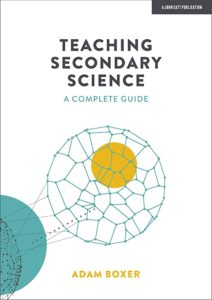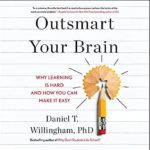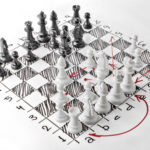Let’s start by making this simple:
First: You should absolutely buy Adam Boxer’s Teaching Secondary Science: A Complete Guide. Sooner is better than later.
Second: You will probably not READ Boxer’s book so much as you will STUDY it. Have a pen handy; some sticky notes; your favorite memory app. Whatever system you use to keep track of big ideas and vital details — have it ready to work.
Now that I’ve been bossy, let me explain why.
Two Big Surprises
I myself don’t teach high-school science. (I taught 10th and 12th grade English, and worked at a summer camp for 8-14 year olds.)
So, the title (Teaching Secondary Science) might suggest that the book isn’t for me.
Well, Boxer’s book (and the precision of his thinking) will absolutely make me a better English teacher; I suspect his approach will benefit almost any teacher.
Here’s why…
Surprise #2:
Longtime readers know my mantra: “don’t just do this thing; instead, think this way.”
That is: cognitive science research cannot provide us with a script (“do this thing”). Instead, that research CAN give us ways to think about memory and attention and motivation and stress. When we “think this way” about those topics, we’ll have better ideas about our teaching.
Well, Boxer’s book comes as close as any to effectively defying this mantra.
His book includes a GREAT MANY “do this thing” kind of instructions.
Phrase your question this way, not that way.
Present topics in this order, not that order.
Calculate cognitive load with this formula, not that formula.
You might think, given my mantra, I’d resist the specificity of his advice.
And yet, over and over, I found myself agreeing with his logic, and believing that I’ll do better classroom work if I understand and follow several of his scripts.
To my astonishment, I’m highly tempted to “do things Boxer’s way.” Why? Because he’s already done so much thinking for me.
Case in Point
I recently discussed Boxer’s book with a group of friends. All of us had highlighted this specific advice:
When introducing a concept, start with examples, not definitions.
Why?
Because definitions are necessarily abstract, and abstraction increases working memory load.
Examples, in contrast, live comfortably in the familiar, concrete world. This very familiarity and concreteness reduce WM load, and thereby makes learning easier.
When my friends and I tried to apply this advice to our own teaching world, we immediately saw its usefulness.
The Spanish teacher said: don’t start with the abstract definition of the subjunctive; start with familiar examples in English.
The PD provider said: don’t start with abstract definitions of “declarative” and “procedural” memory; start with concrete classroom examples.
And so forth.
Two points merit notice here.
First: although Boxer writes about science instruction, his guidance applies widely across disciplines and age groups.
Second: although Boxer’s advice stems from (abstract) cognitive psychology, he frames it in (concrete) teaching suggestions.
That is: over and over, Boxer’s book practices what it preaches. His book does what he tells us teachers should do.
You perhaps have heard a conference speaker give passionate teaching advice (“never talk for more than ten minutes!”), only to defy this advice in his hour-long talk. Boxer carefully avoids such hypocricy.
The Big One
A few of my opinions in this interdisciplinary field approach heresy. Here’s one:
In my view, cognitive load theory helps experts talk with other experts about working memory load in the classroom.
Paradoxically, however, cognitive load theory almost certainly overwhelms the working memory of non-experts. It is, after all, complicated and jargony. (Quick: define “element interactivity” and “germane load.”)
For that reason, cognitive load theory probably isn’t useful as a framework for discussing working memory load with teachers. (Several people whom I admire are howling as they read these paragraphs.)
Boxer does not articulate this heretical claim directly. However, he enacts its conclusion quite directly.
That is: he translates the abstractions of cognitive load theory into a concrete formula — a proportionality formula using words anyone can understand.
Rather than reproduce the mathematical version of the formula here, I’ll summarize it this way:
Task complexity and abstraction increase working memory load.
The student’s background knowledge and the teacher’s support reduce working memory load.
Therefore, to optimize working memory load, we should look out for those four variables and manage them appropriately. (He’s got CHAPTERS on each of those topics.)
If you speak cognitive load theory, you see exactly how Boxer has translated its abstractions into this concrete formulation.
But — crucially — you don’t need to speak cognitive load theory to get its benefits.
Boxer, again, has taken his own advice. He has started with concrete examples rather than abstract definitions; he has thereby made it MUCH easier to learn from this book.
Always with the Limitations
Having raved for several hundred words, let me add a few quick notes of caution.
First: I don’t agree with absolutely everything Boxer writes. (I don’t agree with absolulety everything I write.) For instance: he emphatically champions mini white boards; I don’t think they’ll work in my context.
Second: Boxer’s examples draw on science teaching in high school in England. All three of those truths require some degree of translation as you apply his ideas to your work.
The English education system thrives of mysterious acronyms; you’ll just have to figure them out. When the SLT talks with the NQT about Supply, well, I can’t help you there.
Third: Full disclosure, I should point out that Boxer’s publisher is also my publisher — so I might have a conflict of interest in writing such an enthusiastic review. I certainly don’t think this connection has skewed my perspective, but you should have that information to make your own decisions.
These few points aside, I return to my initial hearty recommendation.
When you read and study Boxer’s Teaching Secondary Science, you’ll get specific and wise guidance for applying the abstractions of cognitive science to your classroom.
You’ll enjoy it, and your students will learn more.




